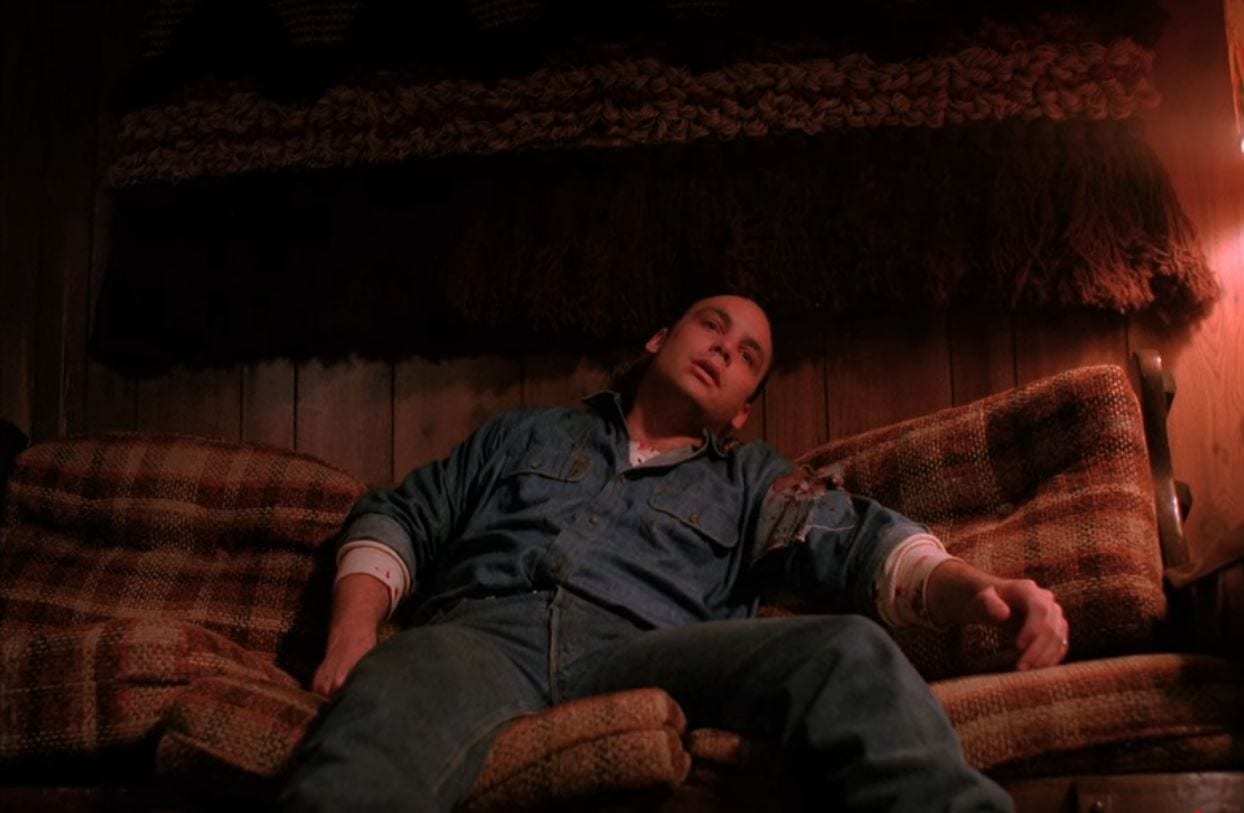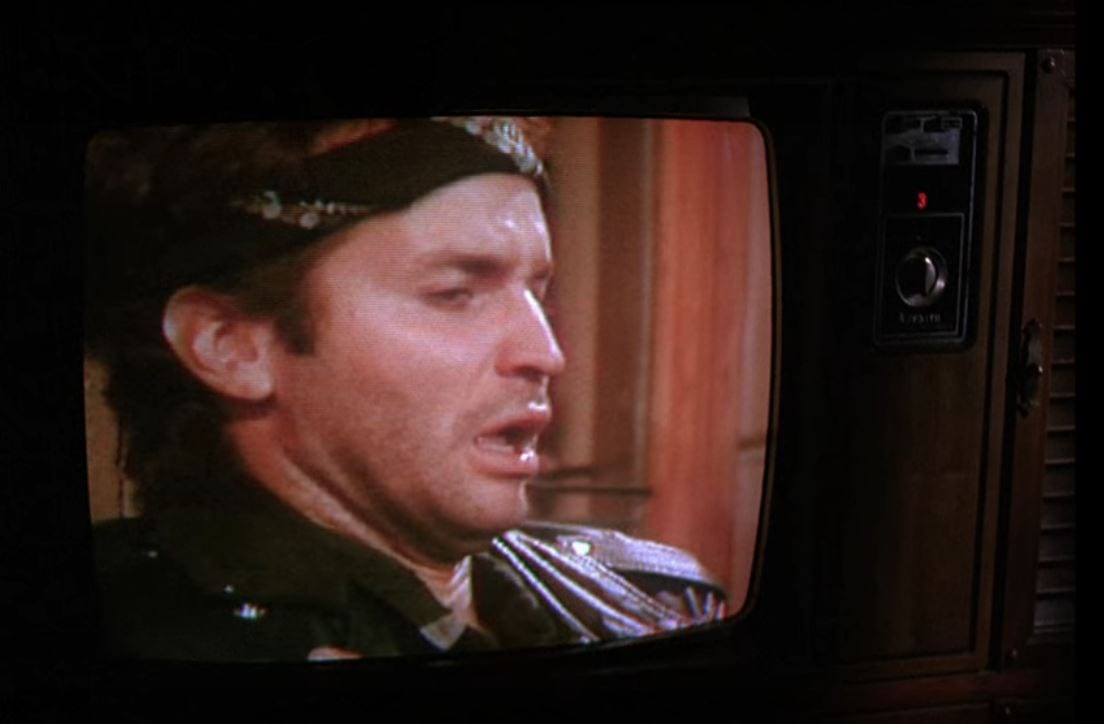Twin Peaks has always been both a TV show and a show about TV, making references to itself and to the broader medium of which it is a part. Its characters are like the dreamer who dreams and lives inside the dream, but this is a dream we are invited to share—it extends beyond the boundaries of the set and into the “real world” at the same as it blurs the lines of what is real and what isn’t. In Episode 7 (the Season 1 finale, written and directed by Mark Frost), Montana is shot on screen in Invitation to Love as Leo is shot on our screens in Twin Peaks, and the whole episode itself plays like a soap opera or overblown season finale full of cliffhangers.
Indeed, Episode 7 is an overblown season finale full of cliffhangers: Jacoby is attacked by an unknown man in Easter Park; Shelly is tied up in the Mill that later bursts into flames, and we don’t know if either she or Catherine (who arrives later) manages to escape (or if Pete will be OK, he charges into the burning building to look for his wife); Nadine has attempted suicide; Bobby has impersonated Leo in order to frame James for cocaine possession; Lucy tells Andy she is pregnant, which causes dissension for reasons unknown; Audrey gasps as Ben Horne enters her room at One-Eyed Jacks; Leo is shot (as previously mentioned); Hank threatens to expose Josie; Andy shoots Jacques, who Leland later kills in the hospital; and the hour ends with Dale Cooper opening the door to his room at the Great Northern to be shot multiple times.
The hour is so overstuffed with events as to be ridiculous, and of course Albert will later make a quip about precisely this—“What happens in Season 2?”—but the feat that Twin Peaks manages to pull off somehow is to nonetheless make it all feel real and lived-in. It does this through various scenes that happen in between the main events, such as the exchange between Pete and Catherine that manages to tell the story of their lives in just a few sentences, or that between Hank and Norma at the Double R, where one is really tempted to believe for a second that Hank truly wants to be good (even though for most of the course of Episode 7 he is extorting people, arranging murders, and even pulling the trigger himself).
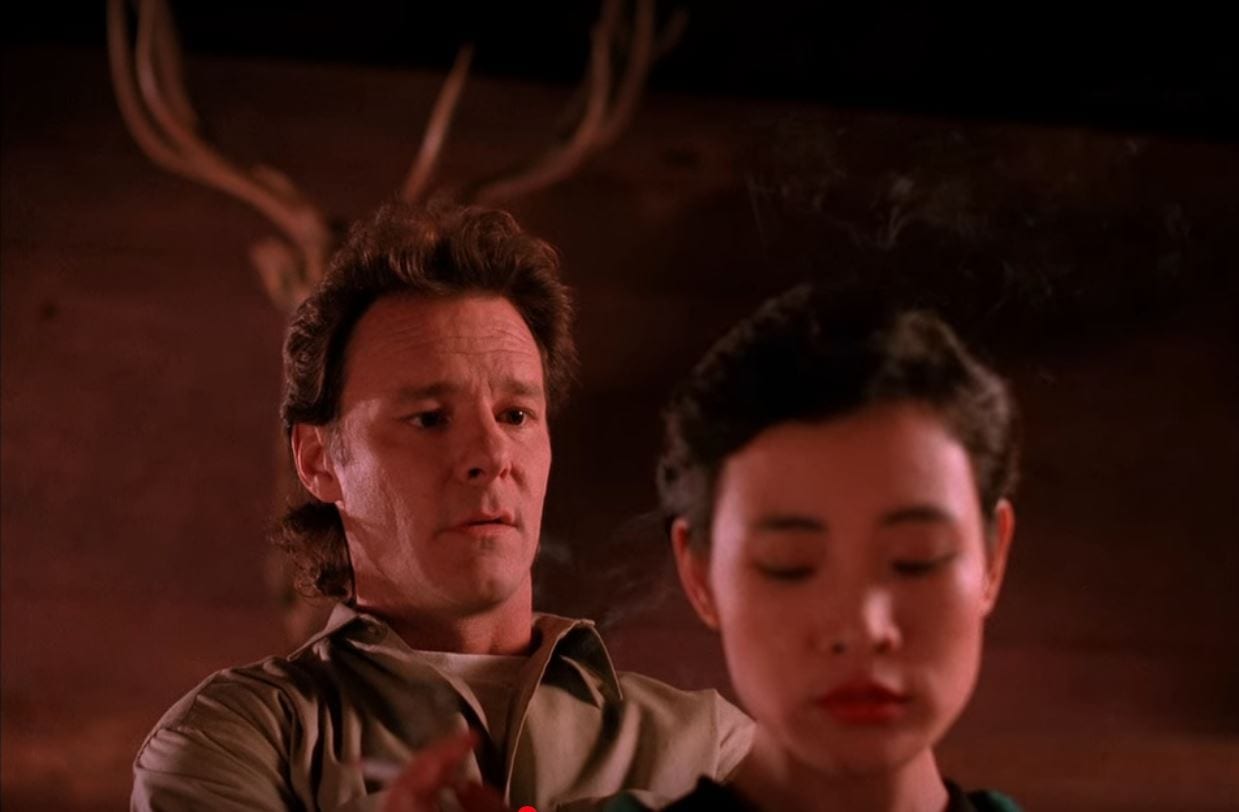
But there is also so much going on that it is easy to lose sight of certain questions, even if—or perhaps particularly if—you have seen Twin Peaks a number of times and know where things are going. It’s as though as a viewer you can be sucked into the story that you know is going to unfold and fail to see the story that is right before your eyes, much like in a dream where you “know” that you are in a certain location, like a house in which you used to live, when in fact the visuals that surround you bear no resemblance to this place, as it’s not a place but a feeling that defines the dream.
Twin Peaks is a properly surrealist work, not (just) in the sense of being “weird” but in something much closer to André Breton’s definition of the surreal as more real than so called “realism” because it includes within it the kind of logic and experience we access in dreams. Everyday reality is imbued with these things too, and one can either be open to them or ignore them. It’s a lot like Dale’s method when he throws rocks at bottles—there is intuition at play, sure, if we want to call it that, or we might call it a different sort of logic. There are resonances between differences and their repetitions, like Montana and Leo suffering from their gunshot wounds at the same time or Cooper being shot in the same place here in Episode 7 as he will be in Part 8 of The Return.
It is possible that Cooper might have died here. That is, one can spin an entire interpretation of Twin Peaks around the idea that Dale is dead, and it holds up (you could even point to the German title of this episode—“The Last Evening”—if you like). But I prefer to think of it as that TV dream that dreams itself and sucks us into its web. The characters live, but only within the dream—though insofar as we share in that dream the web connects outward. They’re still there, waiting to be revisited, between two worlds, fictional and yet real—normal categories fall apart.
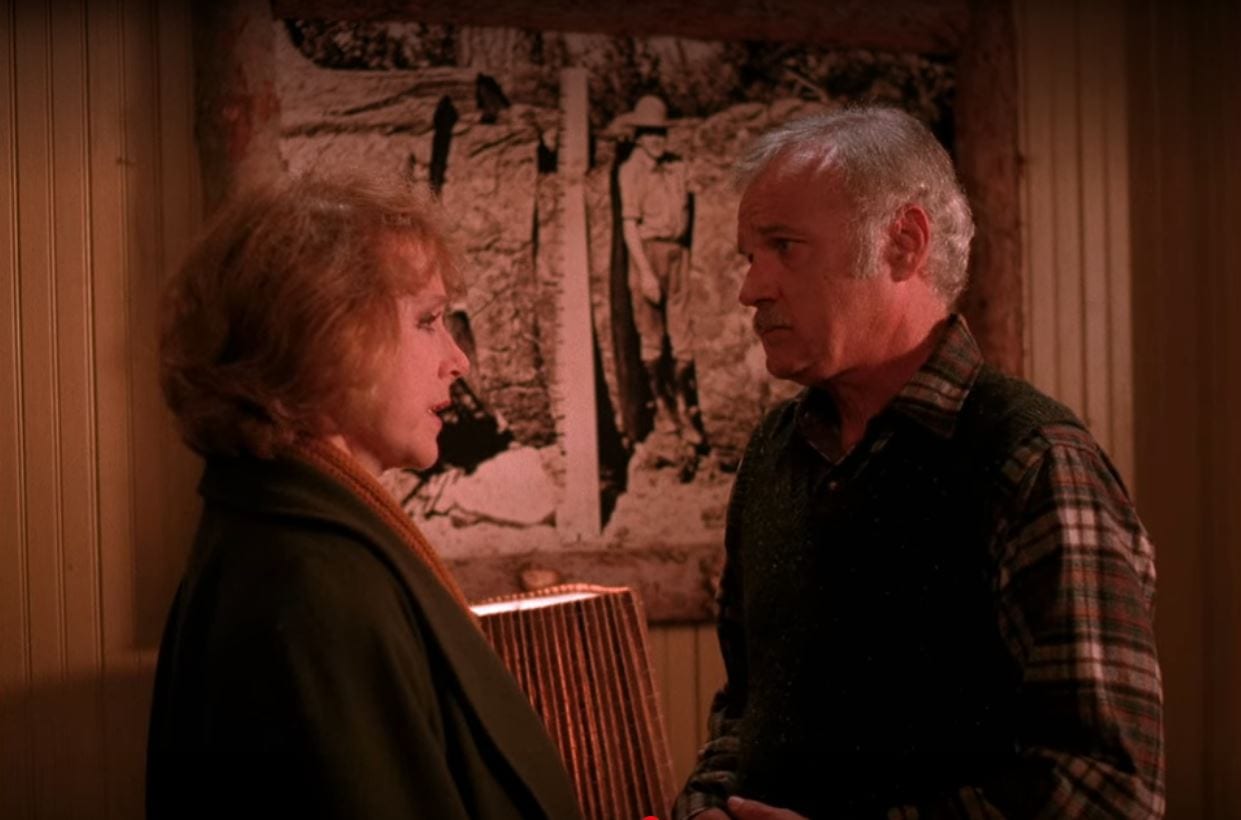
Who attacked Jacoby? So much happens in Episode 7 that one can almost fail to note this question, and so much happens afterwards in Twin Peaks that one can all too easily let it slip away and be forgotten. We could jump to surmise that it was Leland, but I’ve never been convinced that it tracks. The man in the ski mask in that scene certainly doesn’t strike me as Leland, and it would in fact seem rather out of character—perhaps not in terms of the motives for the attack itself, but the very tactic of it involving disguise, not to mention the fact that whoever it was would have seen Maddy dressed as Laura Palmer near the gazebo. I almost prefer to imagine that this is some unnamed and otherwise unknown assailant who is perhaps attacking Jacoby for independent reasons we never discover, making this event in Episode 7 resonate with all of those Roadhouse scenes in The Return where we hardly know the story of the people involved or what is going on.
As a TV show, Twin Peaks primes us to connect this event to the story and to fill in that it must have been Leland, but at the same time TV logic is constantly subverted by the form of Twin Peaks, which is what makes it such a lasting and indelible contribution to the culture.
After all, in Episode 7 we get not only Jacques’ disturbing story about the night when Leo put a poker chip in Laura’s mouth and told her to “bite the bullet, baby” as he was “going to town on her” but also Laura herself saying on the tape she recorded for Jacoby how much she got off on these times that Leo played with trying to kill her. From the beginning, the image of Laura Palmer as a wholesome homecoming queen is undermined and complicated as we get to know Laura as a complex person who was nonetheless a victim.
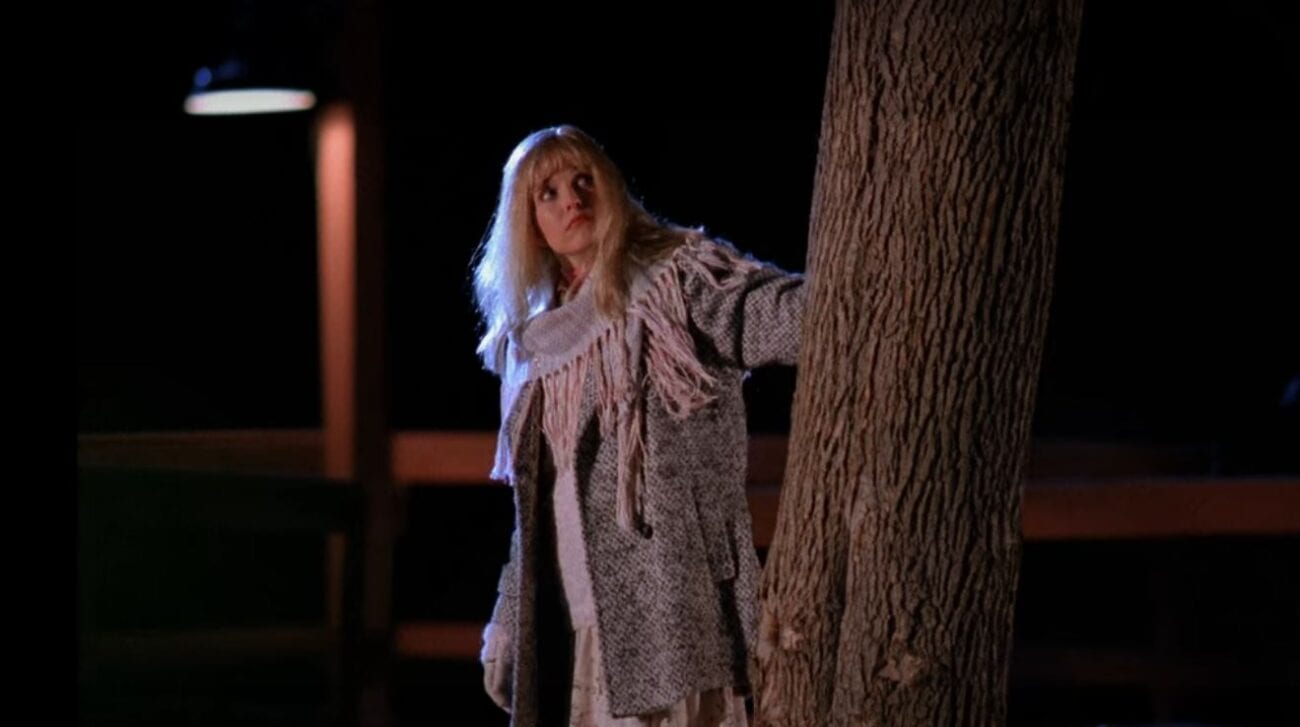
Episode 7 doesn’t give us scenes in the Red Room or the Giant appearing to give Cooper clues or anything like that. On its face, it is a straightforward hour of television much like other season finales full of cliffhangers. But through the sheer number of them and the speed at which they are deployed, it makes reality strange.
This is not (merely) to point out that the events that occur in Episode 7 of Twin Peaks are unlikely to occur in real life. That could be said about almost any TV show. But television conventions have a way of defining their own sense of reality, as we see time and time again in a show like L.A. Law or Dallas. And just in case we might think for a second that Twin Peaks doesn’t know what it’s doing, we get that brief glimpse into Invitation to Love paralleling Leo’s fate.
We know that Leo doesn’t die here. He will go on to have his finest moments in Season 2. But it is worth remembering how vicious he was before being shot. He ties Shelly up in the Mill and blames her for what he’s doing, then later he blames Bobby for killing her as he picks up the ax to chop wood inside go after the young Briggs.
Bobby is also at his darkest in Episode 7, as he attempts to frame James as an “easy rider” and puts cocaine into his motorcycle. He’ll have found his redemption by the time we reach The Return, but don’t forget that Bobby killed a guy. None of the characters in Twin Peaks are straightforward embodiments of tropes—the tropes or stereotypes are there, but always inflected just enough to make us believe that these are real people.

I have gone into greater depth to put forward my thoughts about Dale Cooper elsewhere, but one point of reference I have always found striking is here in Episode 7. That is, it would be all to easy to think that his stint as Mr. Jackpots in The Return comes from nowhere, but we in fact see this aspect of him early in the Season 1 finale as he plays blackjack against Jacques, who is dealing cards at One-Eyed Jacks. The hit Cooper takes to get to 21 is absolutely insane.
We also see some evidence of Mr. C during these scenes, as he claims to be the money man behind Leo’s operation and asks Jacques questions about the poker chip. It’s true that you might interpret this as merely Dale working well undercover in order to learn information and coax Jacques across the border, but we’re also already seeing indications of Cooper’s willingness to operate outside of Bureau guidelines in pursuit of what he wants. And I would suggest the problem with Dale lies not so much in the goal but in the wanting.
Does Dale actually die from the bullet wounds he receives at the end of Episode 7? I don’t think so, but what I would want to push back against the most is the notion of an interpretation of Twin Peaks that involves some kind of starkly demarcated line between the real and the unreal, or between life and death. Rather, the whole story is in that in-between, like the dream of the dreamer who lives within the dream.
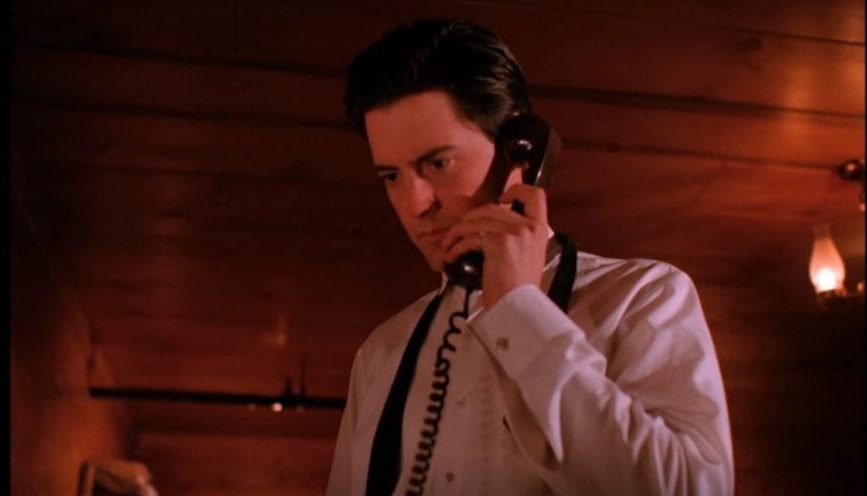
Dale answers the phone in his room at the Great Northern at the end of Episode 7, and the voice on the other end doesn’t come through right away. There is interference, or static on the line. David Lynch will repeat the symbol of electrical wires, and a telephone pole, in Fire Walk with Me and The Return—this is a symbol of the in-between, as the wires transfer a voice by electrical pulse down the line. A voice and nothing more, disembodied from its owner, comes through the line finally but only after Dale has set the phone down to answer the door. So it is a missed connection. We’re left with Andy hollering into the void as a bleeding Dale lies on his hotel room floor.
It’s all there in this scene, just as the thematic unity of Twin Peaks is always there whether an episode is directed by David Lynch, Mark Frost, or someone else. Twin Peaks is a dream, and if the question “Who is the dreamer?” isn’t taken as a koan—if we are to attempt to answer—then the only answer can be that it is all of us—actors, characters, directors, writers, and viewers alike—who confabulate together this oneiric space, to live and breath inside it.


